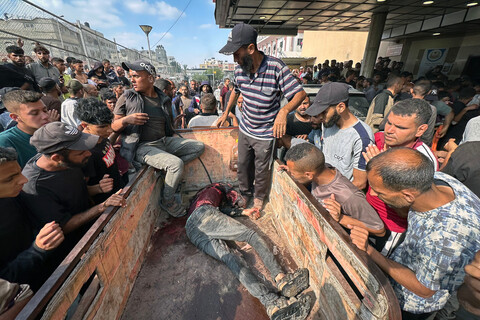The Electronic Intifada 6 June 2025

Rahaf Ayad, 12, photographed in Gaza City on 5 May, in critical condition due to malnutrition and undiagnosed illnesses amid Israel’s total closure of Gaza’s crossings.
APA imagesHundreds of Palestinians were killed in the occupied Gaza Strip during the month of May as Israel escalated its attacks, bringing to more than 54,000 the number of Palestinians killed in the territory since 7 October 2023.
Towards the end of the month, the health ministry in Gaza stopped including casualties in the North Gaza governorate in its daily updates due to the area being rendered inaccessible following the onset of a major military offensive.
Meanwhile, Israeli settler violence continued to rise in the West Bank, which has seen the highest rate of injuries due to settler violence in at least 20 years, according to the UN Office for the Coordination of Humanitarian Affairs.
“Since the beginning of 2025, OCHA has documented 591 settler incidents resulting in casualties or property damage – an average of four per day, mirroring 2024, the highest year on record,” the UN office said.
“The severity of these attacks has intensified, with a total of 223 Palestinians injured by Israeli settlers since January, marking a monthly average of 44 – the highest recorded since OCHA began tracking casualties in the West Bank in 2005,” OCHA added.
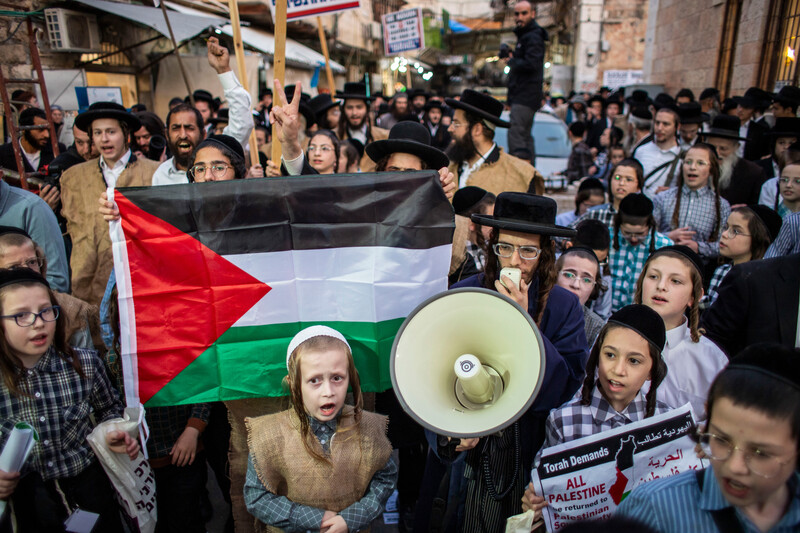
Members of the ultra-Orthodox Jewish group Neturei Karta hold their 77th annual march mourning the existence of the state of Israel in the Mea Shearim neighborhood of Jerusalem, 1 May. Neturei Karta believe that the Jewish people are religiously obligated to remain in exile until the coming of the Messiah, and therefore see the modern state of Israel as a betrayal of the Torah. During the demonstration, riot police entered the neighborhood, attacked protesters and arrested one participant.
ActiveStillsThe entire community of Maghayer al-Deir, near the West Bank city of Ramallah, was displaced during May. More than 33,000 people remain displaced and unable to return to their homes in Jenin, Nur Shams and Tulkarm refugee camps since a major Israeli military offensive forcibly displaced people in those areas of the West Bank in January.
On 1 May, the Israeli military issued new demolition orders that would see the razing of more than 100 homes in Tulkarm and Nur Shams refugee camps.
The UN agency for Palestine refugees, UNRWA, said that if enacted, the demolition orders “would further entrench the displacement of thousands of Palestine refugees in the northern West Bank.”
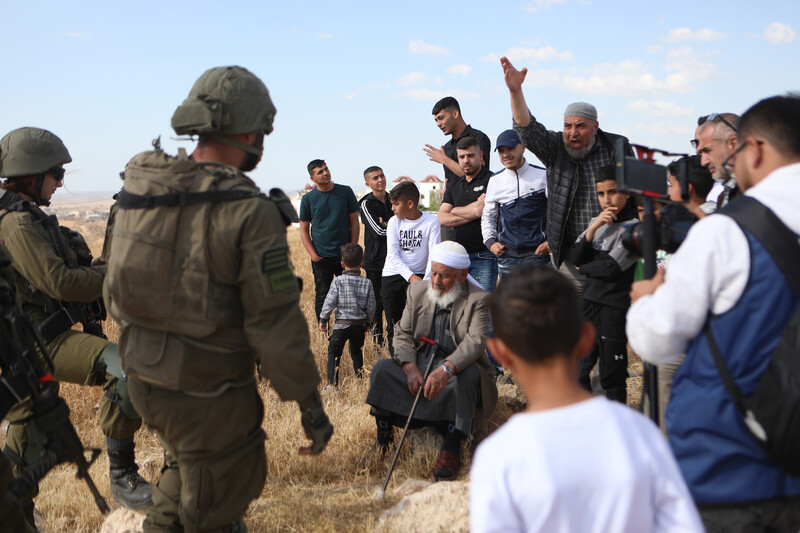
Israeli forces prevent Palestinians from accessing their lands that are threatened with confiscation in al-Dhahiriya, south of the West Bank city of Hebron, 2 May.
APA imagesA ship carrying humanitarian aid organized by the Freedom Flotilla Coalition bound for Gaza was attacked by drones in international waters off of the coast of Malta on 1 May. Organizers said that 30 people were on board the ship when it was bombed.
Ten people lost their lives after Israeli commandos stormed a ship in international waters in May 2010, preventing a flotilla from breaking the siege on Gaza.
Also on 2 May – World Press Freedom Day – the UN Human Rights Office in Palestine said that it had “independently verified the killing of 211 journalists in Gaza since 7 October 2023, including 28 woman journalists.”
Nearly 50 of those journalists were on duty when they were killed. Around 50 Palestinian journalists were being held in Israeli detention as of 29 April, the UN office added, citing the Palestinian Commission of Detainees and Ex-Detainees Affairs.
Israel meanwhile is denying foreign journalists entry to Gaza except for “limited army-controlled visits,” the UN office noted.

Palestinians attend the funeral of 29-year-old Alaa Khader in the West Bank village of Beita after he was killed by Israeli forces the previous night, 2 May. The killing occurred as the forces imposed a complete closure on the village, located near Nablus.
ActiveStillsOn 6 May, the Israeli military killed Muhammad Iyad Tabasi in a drone strike that the Euro-Med Monitor said “directly targeted” the 24-year-old near the displacement camp in southern Gaza where he was staying.
Israeli intelligence contacted Tabasi, a sanitary worker at a field hospital, several times in the weeks leading up to his killing, “requesting that he cooperate with them,” according to Euro-Med Monitor.
The rights group said that it has “received numerous testimonies from families whose relatives were deliberately killed or targeted after refusing to cooperate with Israeli intelligence.”

Firas Wishah, 40, lives in a tent erected atop the ruins of his destroyed home in al-Bureij refugee camp in central Gaza. Photographed on 3 May, Wishah lost 18 members of his family in an Israeli airstrike that targeted their home. He continues to search through the rubble for the bodies of other relatives still missing beneath the debris. Among the few things he has salvaged are his children’s toys, which he has placed outside the tent — a small attempt to preserve the memory of those he lost.
APA imagesOn 7 May, independent UN human rights experts said that third states “must act now to end the violence or bear witness to the annihilation of the Palestinian population in Gaza – an outcome with irreversible consequences for our shared humanity and multilateral order.”
They warned that the present situation “conveys a deadly message: Palestinian lives are dispensable, and international law, if unenforced, is meaningless.”
The US-based charity World Central Kitchen announced on 7 May that it had halted its food relief work in Gaza, where Israel had imposed a total siege since early March, after it ran out of ingredients to provide free meals to thousands of people in the territory.
Amjad al-Shawa, the head of the Palestinian Non-Governmental Organizations Network, told Reuters that most of the 170 community kitchens operating in Gaza had shut down due to Israel’s total blockade.
Al-Shawa said that the closure of the kitchens “would cause a drop of between 400,000 to 500,000 free meals per day for the 2.3 million population,” Reuters added.
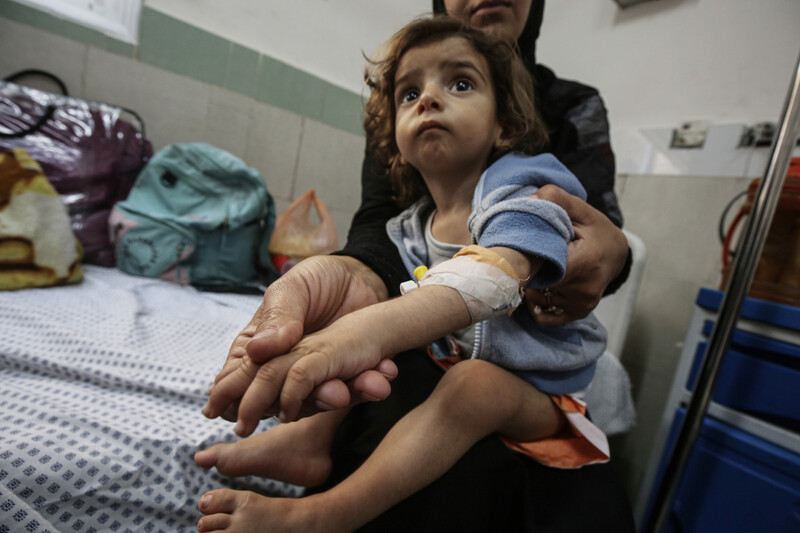
Jihad Saad, who is 1 year and 4 months old, receives medical care at Al-Rantisi Children’s Hospital in Gaza City accompanied by his mother, 4 May. The child is suffering from severe malnutrition due to a critical shortage of food supplies following Israel’s total closure of Gaza’s crossings for more than two months.
APA imagesHamas said that its fighters had engaged in “fierce fighting” with Israeli troops in southern Gaza on 8 May. The group claimed that its fighters had ambushed soldiers with rockets, killing and injuring several.
“The statement, issued on Telegram, suggests that Hamas is still active in areas where the Israeli military has expanded its control, more than 19 months after the start of Israel’s air and ground campaign in Gaza,” Reuters observed.
On 9 May, a UN special committee, upon completing a field mission, stated that the use of torture and ill-treatment, including sexual violence, is “a systematic practice” of the Israeli military and security forces “and is widespread in Israeli prisons and military detention camps.”
The UN committee said that the methods employed by Israel “read as a playbook of how to try to humiliate, derogate and strike fear into the hearts of individuals.”
“First comes sexual harassment, inappropriate touching of private parts, then sexual abuse, then the threat of rape, and then rape itself, including gang rape, and often with foreign objects such a sticks and batons, against men, women and even children,” the UN committee added.

Israeli forces raid the West Bank city of Nablus on 4 May.
APA imagesOn 12 May, a study was released finding that nearly half a million people in Gaza were “facing catastrophic hunger … and the entire population is experiencing acute food insecurity,” the World Food Program said.
“The report also projects an alarming 71,000 children and more than 17,000 mothers will need urgent treatment for acute malnutrition,” the UN food agency added.
More than 116,000 metric tons of food aid and “hundreds of pallets of lifesaving nutrition treatments” are waiting to be brought into Gaza, the World Food Program added, but without specifying that Israel was responsible for the closure of the crossings.
Rik Peeperkorn, a World Health Organization representative, said that acute malnutrition is an “increasing trend.” He added that “without enough nutritious food, clean water and access to healthcare, an entire generation will be permanently affected.”
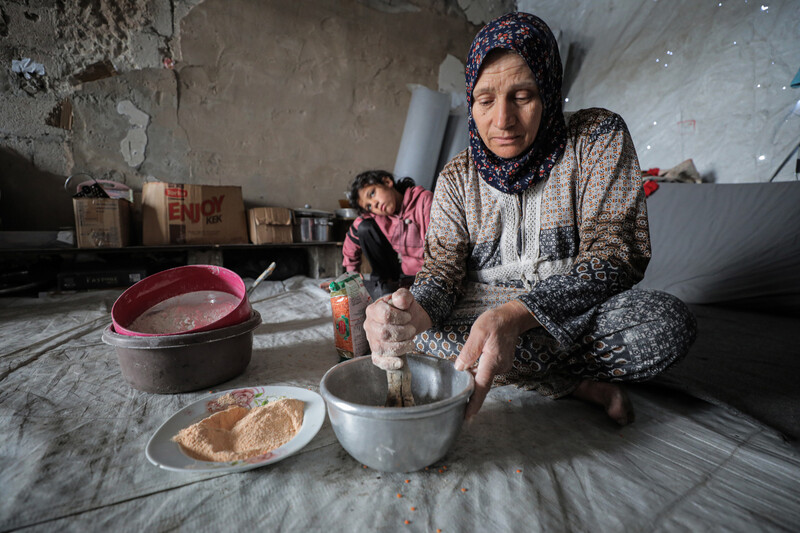
Umm Amjad al-Masri, 58, grinds pasta and lentils to bake bread to feed her 10 children inside a shelter for displaced people in an UNRWA school in Jabaliya refugee camp, northern Gaza Strip, 4 May.
APA imagesIn a joint statement, nearly 250 organizations based in and outside of Palestine stated that Israel’s obstruction “is being done in open defiance of the core principles of international law” and in violation of binding legal orders handed down by the International Court of Justice more than a year ago.
The organizations called for the immediate organization and deployment of a high-level diplomatic convoy to accompany aid into Gaza through Rafah crossing on the Egyptian border.
Also on 12 May, Edan Alexander, a US citizen serving in the Israeli military who was held in Gaza after being captured while on duty on 7 October 2023, was unconditionally released by Hamas in an apparent goodwill gesture towards the Trump administration in Washington. In April, Hamas said that it had lost contact with the soldier’s captors after an Israeli attack.
In the days leading up to Alexander’s release, Donald Trump’s Middle East envoy Steve Witkoff reportedly told the families of some of the remaining captives in Gaza that Israel was needlessly prolonging the war and that Washington sought a new ceasefire and prisoner exchange deal.
Benjamin Netanyahu, the Israeli prime minister, said in early May that 21 of the captives were still alive, and that there were doubts about the survival of three others.

A child suffering from malnutrition is treated at Nasser Medical Complex in Khan Younis, southern Gaza, amidst a shortage of the necessary medicines and food, 5 May.
APA imagesIsrael relentlessly pounded Gaza following Hamas’ unconditional release of the last US citizen being held alive in Gaza.
On 13 May, Israel killed journalist Hassan Esleih in a drone strike targeting the room at Nasser Medical Complex in Khan Younis where Esleih was being treated after surviving an attack on 7 April that killed two other journalists.
Another patient in addition to Esleih was killed in the 13 May strike and another 12 people were injured.
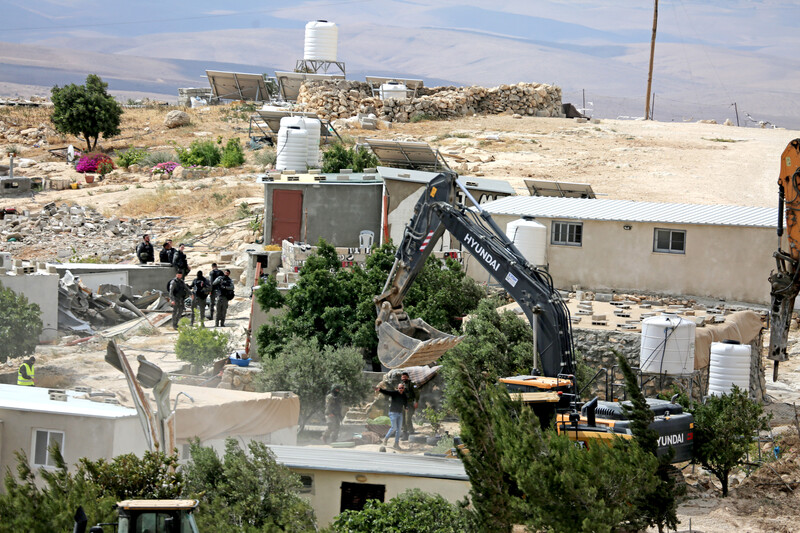
Israeli forces demolish homes and other structures in the village of Khalet a-Daba, located in the Masafer Yatta area in the southern West Bank on 5 May. The demolitions displaced around 50 Palestinians, 21 of them children.
ActiveStillsAlso on 13 May, Israeli warplanes attacked the European Gaza Hospital and its surroundings in intensive airstrikes, killing more than 35 people, “including entire families wiped out in their homes or on the streets,” according to Euro-Med Monitor.
“Israeli forces reportedly blocked civil defense teams from rescuing or evacuating victims by deliberately targeting them,” the rights group added. Additional attacks on the hospital the following day killed and injured more civilians.
Israeli media reported that the purported target of the massive strikes in the European Gaza Hospital area was Mohammed Sinwar, believed to be the leader of Hamas in Gaza after his brother Yahya was killed in battle last year.
Israel claimed that it targeted underground infrastructure beneath the hospital but, as BBC Verify pointed out, “didn’t provide evidence of this.” Instead, it released a video purporting to show the hospital but instead depicted a nearby school.
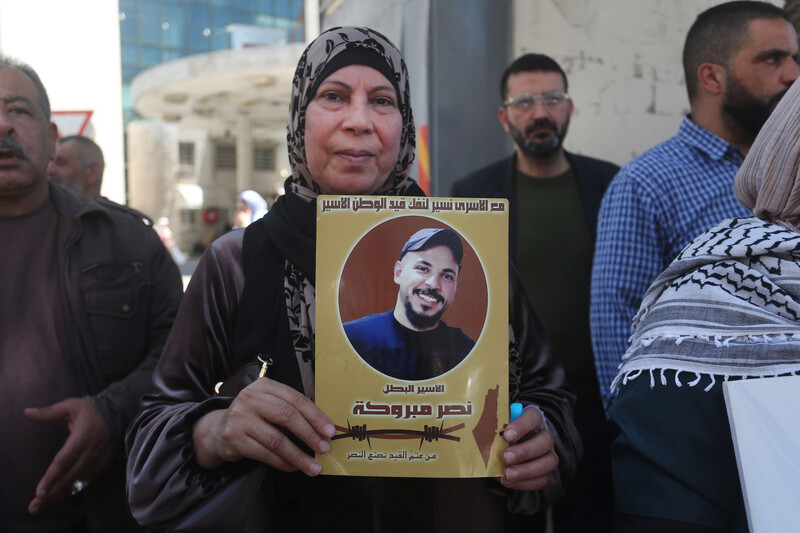
Palestinians demand the release of their loved ones from Israeli prisons and detention centers in the West Bank city of Nablus on 6 May.
APA imagesThe Palestinian Center for Human Rights said later in the month that the attacks on the European Gaza Hospital and its proximity “extinguished the last glimmer of hope for … cancer patients to access treatment within the Gaza Strip, sentencing them to a slow death.”
The Palestinian health ministry in Gaza said on 29 May that following the recent attacks on the hospital and the evacuation of its patients, chemotherapy and follow-up care for cancer patients had completely ceased in the territory.
Previously, dedicated cancer treatment departments at the Turkish-Palestinian Friendship Hospital and Al-Rantisi Pediatric Hospital were forced to shut down following Israeli attacks and were used as military barracks.

People inspect the damage caused by an Israeli airstrike targeting a school being used to house displaced people for the second time in al-Bureij refugee camp, central Gaza Strip, 7 May.
APA imagesThe temporary Friendship Field Hospital was also recently forced out of service following Israeli attacks, leaving cancer patients with no ways of accessing cancer treatment in Gaza.
Only 1,110 out of 12,500 cancer patients have been able to leave Gaza since October 2023, according to the Palestinian Center for Human Rights – only around half of them left since Israel forced the closure of Rafah crossing in May 2024.
The rights group said that around 615 cancer patients died in Gaza between October 2023 and April 2025, “while approximately 2,700 others in advanced stages of the disease await treatment.”
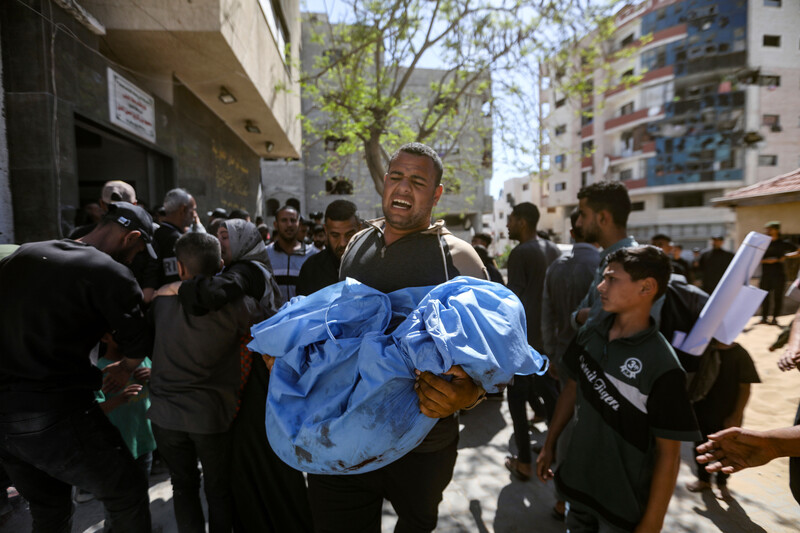
Palestinians mourn at Al-Shifa Hospital after their loved ones were killed in airstrikes in a crowed area in Gaza City, 7 May. The nearly simultaneous strikes, which killed at least 33 Palestinians and wounded dozens, targeted a restaurant and a nearby market on al-Wihda Street in al-Rimal neighborhood, one of Gaza’s busiest commercial areas. Palestinian journalist Yahya Sobeih was among those killed in the attack, just hours after his wife gave birth to their first chid.
ActiveStillsOn 15 May, Human Rights Watch said that Israel’s plan to “demolish what remains of Gaza’s civilian infrastructure and concentrate the Palestinian population into a tiny area would amount to an abhorrent escalation of its ongoing crimes against humanity, ethnic cleansing and acts of genocide.”
The rights group noted that Israeli leaders have threatened to move forward with the plan if no “deal” with Hamas was reached by mid-May.
Israel’s plan, dubbed “Gideon’s Chariots,” “involves forcibly displacing much of the Palestinian population of Gaza while seizing and occupying the territory,” Human Rights Watch stated. The group added that “these plans trigger the ‘duty to prevent’ under the Genocide Convention.”
“Continued weapons sales, military assistance and diplomatic support to the Israeli government despite overwhelming evidence of atrocity crimes … expose governments and officials to the risk of complicity,” Human Rights Watch said.
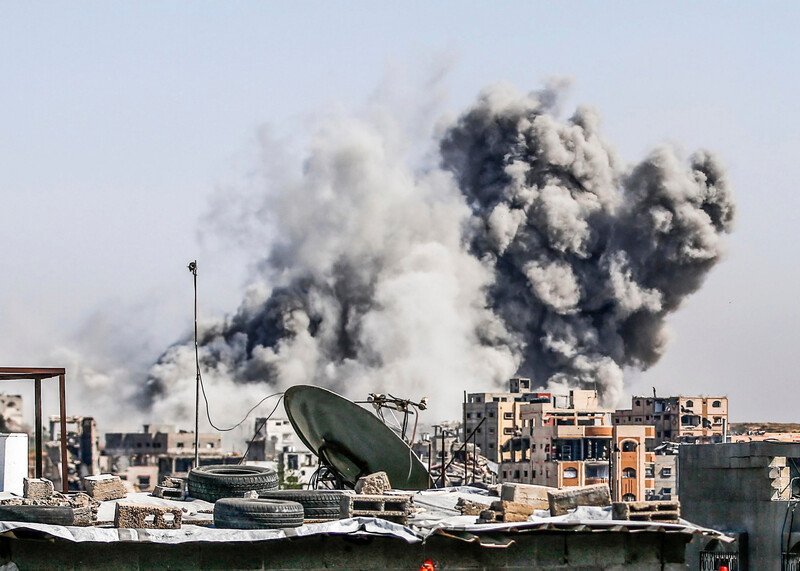
Smoke rises over residential buildings following an Israeli airstrike on the al-Tuffah neighborhood in the eastern part of Gaza City on 9 May.
APA imagesOn 16 May, the UN human rights office in the West Bank and Gaza Strip called for an end to Israel’s extrajudicial executions and “other unlawful use of force in the West Bank.”
“Over the last two weeks, Israeli security forces have killed two Palestinian men in planned summary executions,” the UN office said, “while seven Palestinians were killed in conditions that raise concerns of the use of unnecessary or disproportionate lethal force.”
On 8 May, Israeli undercover forces shot and killed a Palestinian man while he was attempting to surrender in the West Bank city of Nablus.
According to the UN, CCTV footage shows that the undercover forces “shot him again as he lay on the ground injured and incapacitated, seemingly to ‘confirm the killing.’”
Days earlier, on 2 May, another Palestinian man wanted by Israel was gunned down by undercover Israeli forces in Balata refugee camp in Nablus.

People observe the damage caused by an Israeli airstrike that targeted the UNRWA supply center in Jabaliya refugee camp, northern Gaza, 10 May.
APA imagesOn 19 May, the Israeli military attacked Nasser Medical Complex, severely damaging a warehouse built by the World Health Organization and destroying critical medical supplies stored in the facility.
“Amid critical shortages, escalating violence, and a rising number of casualties, this is a devastating blow that will cost lives,” the UN health organization said.
After nearly 80 days of total blockade, nine trucks carrying aid were permitted by Israel to enter Gaza on 19 May. Tom Fletcher, a senior UN official, said that the trucks were “a drop in the ocean of what is urgently needed.”
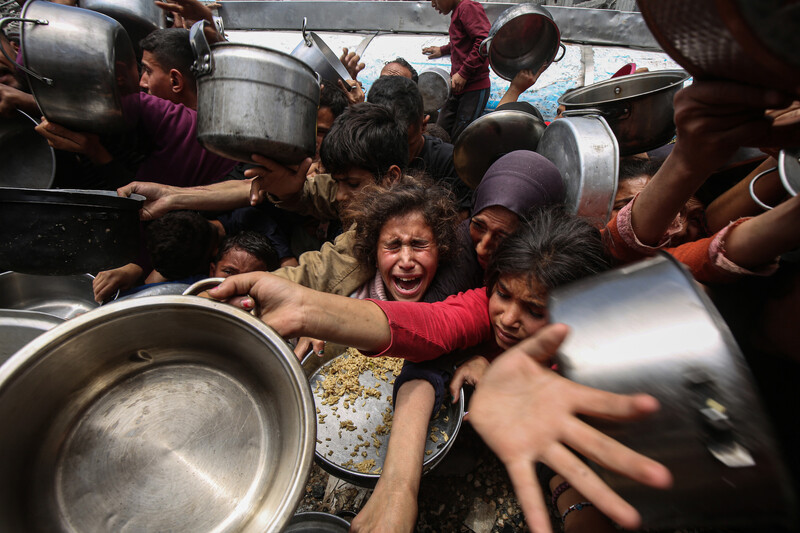
Palestinians wait to receive food at a charity kitchen in Jabaliya, northern Gaza, 14 May.
APA imagesBy 28 May, only around 200 truckloads were collected by humanitarian organizations on the Palestinian side of the Israeli-controlled Kerem Shalom crossing “due to insecurity and restricted access,” OCHA said.
Meanwhile, Israel was prohibiting “the storage of humanitarian cargo inside Gaza, except for limited exemptions granted to select food and nutrition actors to store limited quantities,” OCHA added. “Most of the aid must thus be dispatched directly for distribution, resulting in significant operational challenges.”
“Additional restrictions by Israeli authorities include preventing the direct distribution of wheat flour to families,” OCHA said.
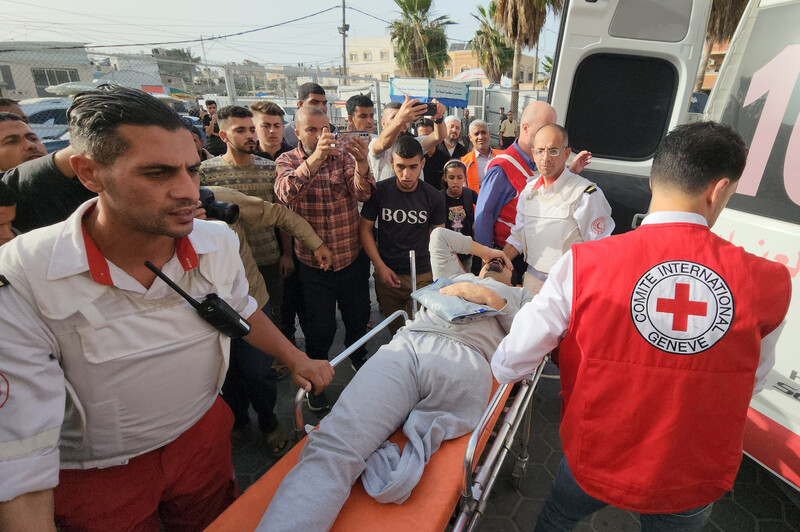
A Palestinian man newly released from Israeli detention is transferred to Al-Aqsa Martyrs Hospital in Deir al-Balah, central Gaza, on 16 May.
APA imagesA coalition of prominent humanitarian and human rights groups rejected the establishment of the so-called Gaza Humanitarian Foundation in a joint statement on 19 May.
The Washington-backed scheme, eventually revealed to have been bankrolled by Tel Aviv, involves the use of former US military staff to distribute limited quantities of food aid at designated hubs in Gaza that are under full Israeli military control.
The humanitarian and human rights groups said that the scheme, “wholly dependent on Israeli coordination” and operated via “Israeli-controlled entry points … entrenches and legitimizes the very structures of control that are responsible for cutting Gaza off from food, fuel and medicine.”

Amid ongoing Israeli attacks and harsh living conditions, people gather on the coast of Gaza City to cool off during a heatwave on 17 May.
APA images“Let us be clear: the biggest barrier to humanitarian access in Gaza is not inefficiency or corruption, it is the deliberate restriction of aid by the Israeli government,” the groups added.
Noting the use of armed private contractors in violation of the principle of neutrality, the groups said that “aid that is used to mask ongoing violence is not aid, it is in fact humanitarian cover for a military strategy of control and dispossession.”
The Lemkin Institute for Genocide Prevention and Human Security said that the scheme amounts to “a weaponization of food and a grotesque mockery of humanitarianism.”
“We call it for what it is: A tool of genocide,” the Lemkin Institute added.
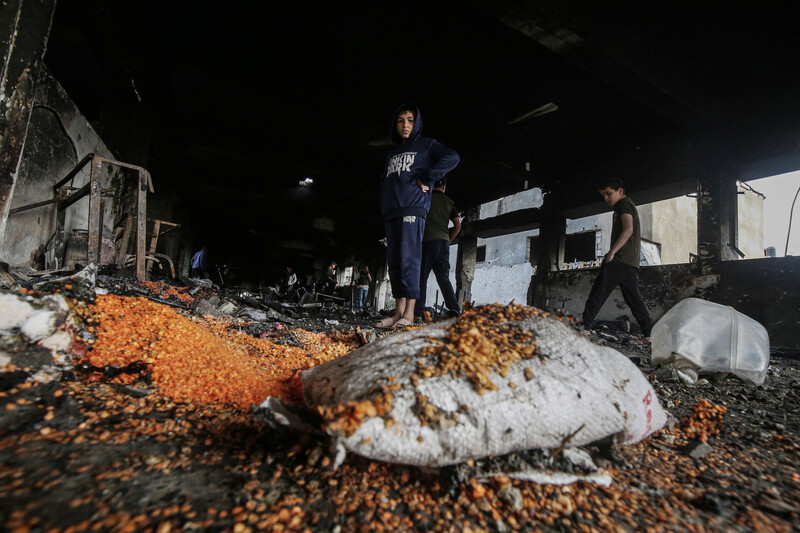
People observe the damage at a school sheltering displaced people after an Israeli airstrike in Gaza City, 20 May.
APA imagesUN Women, an organization in the UN system, stated on 19 May that it estimates that more than 28,000 women and girls have been killed in Gaza since October 2023: “that is one woman and one girl on average killed every hour in attacks by Israeli forces.”
With the tightened blockade, the organization added, every woman and girl in Gaza “is facing catastrophic levels of hunger.”
A group of 20 independent UN human rights experts urged the Security Council to take up “the grave and gendered impacts of the unfolding genocide on women and girls in the besieged Gaza Strip.”
In their joint statement, the experts added that “nearly 71,000 children and 17,000 pregnant and breastfeeding women will need urgent treatment for acute malnutrition in the immediate future.”
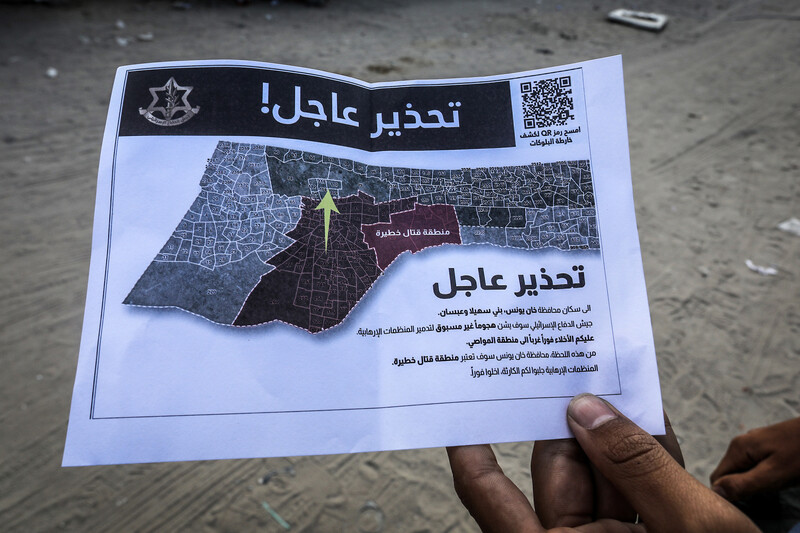
An evacuation order dropped by the Israeli army in Khan Younis, southern Gaza, 20 May.
DPA via ZUMA PressThe UN human rights office issued a statement on 20 May warning against waves of settler violence and collective punishment towards Palestinians in the West Bank following the shooting death of a pregnant Israeli woman near a settlement in the Salfit area on 14 May.
The baby of the Israeli woman, who was being driven to a hospital to give birth when she was shot, was delivered by emergency C-section but died two weeks later.
Eight Israelis have been killed in the West Bank since the beginning of the year.
“Four settlers and two members of Israeli forces were killed in shooting attacks or alleged attacks believed to be perpetrated by Palestinians,” according to OCHA, “and two members of Israeli forces were killed by Palestinians while conducting operations.”

The bodies of two children are transferred to Al-Awda Hostpial after an Israeli raid on Nuseirat refuge camp, central Gaza Strip, 21 May.
APA imagesFive Palestinian fighters were reportedly killed in the West Bank hours after the shooting of the Israeli woman. The military wing of Islamic Jihad said that five of its members were killed during a siege on a residential building in Tamoun village, Reuters reported.
Defense for Children International-Palestine said that a 17-year-old was killed during the siege on the building, which was demolished during the attack.
The rights group said that Israeli forces removed the body of the boy, named Reda Kamal Bani Odeh, along with the bodies of three of the other slain Palestinians in the blade of a military bulldozer “and are withholding them.”
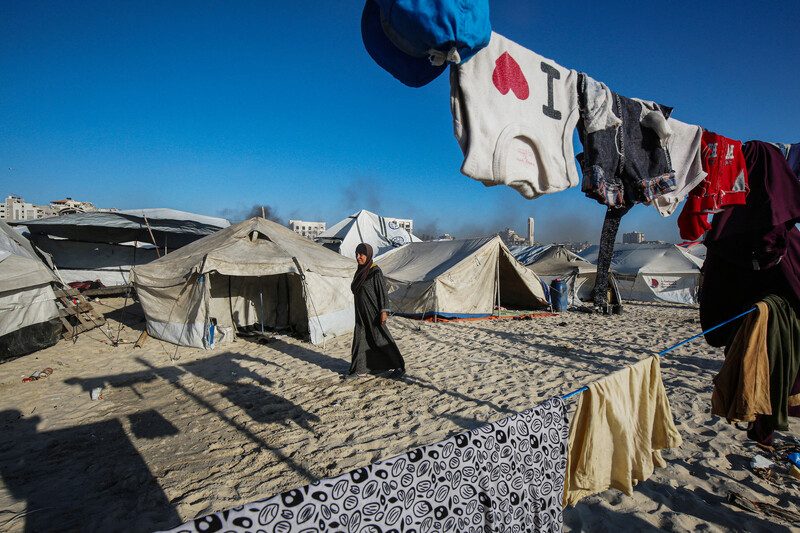
A woman walks through a temporary shelter for displaced people in the seaport area of western Gaza City on 21 May.
APA imagesTwo other Palestinian boys were shot and killed by Israeli forces in separate incidents in the West Bank in the following days.
Muhammad Nidal Abu Libdeh, 17, was shot by Israeli forces and left to bleed without first aid being rendered near one of the gates to al-Aqsa mosque in the Old City of Jerusalem on 16 May.
“Israeli officials claimed the shooting was in response to a suspected stabbing attempt of a policeman,” according to Defense for Children International-Palestine.
The following day, Nidal Wael Shagnoubi, 16, was fatally shot when soldiers ambushed a group of Palestinian youths near the main entrance to Burqa village near Nablus. Soldiers left the boy to bleed without providing first aid and fired warning shots towards an ambulance crew who attempted to reach the child, according to DCIP.
So far this year, 28 Palestinian have been killed by Israeli forces in the West Bank, DCIP said after a 14-year-old boy was fatally shot by soldiers who “opened fire on him suddenly and without warning” at the entrance to Sinjil village near Ramallah on 2 June.
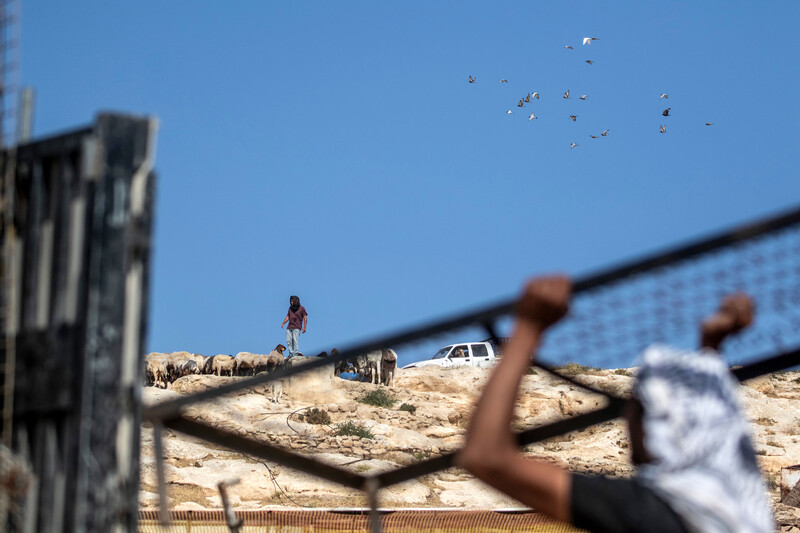
A Palestinian resident of the West Bank village of Mughayir al-Deir dismantles a structure while an Israeli settler herds sheep, 22 May. The residents of Mughayr al-Deir are refugees from the Nakba who have lived in the village for approximately 50 years. They are being forced from their homes because of the near-constant terror from settlers.
ActiveStillsMeanwhile, following the shooting death of the Israeli woman, Israeli forces closed the entrances to the Palestinian villages Kafr al-Dik and Bruqin and placed their residents under curfew and carried out violent mass arrests, land theft and property damage.
The UN office observed that on 15 May, “an Israeli minister publicly called on Israel to ‘flatten’ the two Palestinian communities and make them look like ‘Shujaiya and Tel al-Sultan’ in Gaza.”
The UN office added that settlers closed an entrance used to access several villages in the Masafer Yatta area in the South Hebron Hills for several hours on 15 May and destroyed a wind turbine on 19 May, leaving the village of Qawawis without electricity.

A mural reading “Free Palestine” is seen in a camp for displaced Palestinians at the Gaza City port, 23 March. Displaced Palestinians from Beit Lahiya and Jabaliya are living in overcrowded and harsh conditions at the Gaza port after being forcibly displaced by the Israeli military.
ActiveStillsOn 18 May, Israeli forces shot and killed a man in Bruqin while he was being detained and the home where the slain man lived with his wife and children was reportedly being used as a military post, according to the UN human rights office.
“In parallel, settler groups also called for revenge and escalated attacks against Palestinians, taking advantage of the situation to establish new outposts, in their continued efforts to forcibly displace increasing numbers of Palestinians and take over their land,” the UN office said.
Meanwhile, more than 20 independent UN human rights experts issued a joint statement condemning Israel’s attacks on schools run by the agency for Palestine refugees (UNRWA) and being used as shelters for displaced people in Gaza “and the storming and forcible closure of UN schools in Jerusalem.”
At least 30 civilians were killed in two Israeli strikes on an UNRWA school sheltering some 2,000 people on 7 May. Most schools in Gaza have sustained direct hits since October 2023, including around one-third of UNRWA’s schools in the territory, while satellite imagery shows that “95 percent of Gaza’s schools have sustained damage, rendering the vast majority unusable,” the UN experts stated.
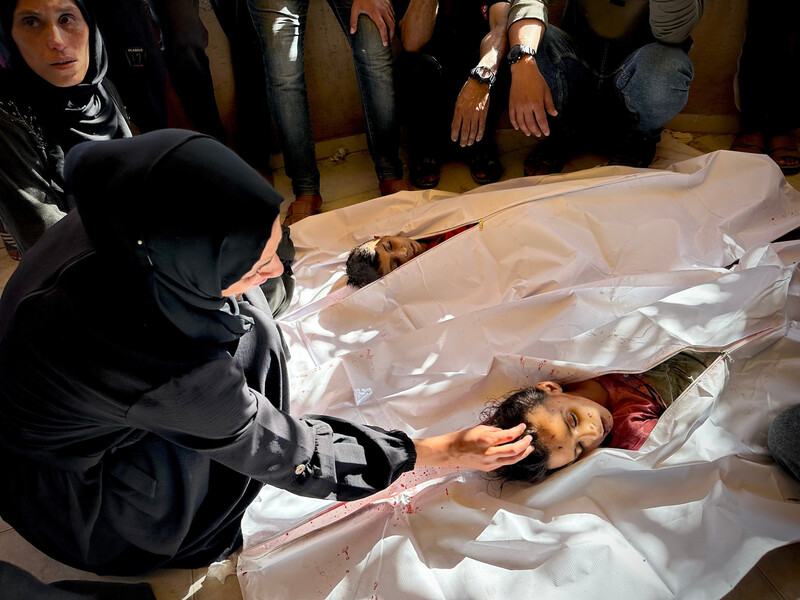
Mourners bid farewell to children killed in Israeli strikes during a funeral at Nasser Medical Complex, in Khan Younis, southern Gaza Strip, 23 May.
APA imagesThe experts noted that in East Jerusalem on 8 May, “heavily armed Israeli forces stormed three UNRWA schools in Shuafat refugee camp while classes were in session, violently evicting over 550 Palestinian children, some as young as six, from their classrooms.”
By the end of the day, “all six UNRWA schools in East Jerusalem had been evacuated,” the experts added.
Later in the month, UNRWA said that a group of Israelis, including a lawmaker, forced their way into the agency’s headquarters in East Jerusalem in an “illegal provocation” on the occasion of so-called Jerusalem Day on 26 May.
“The group brought flags and erected banners, seeking to claim the compound for the establishment of a new Israeli neighborhood,” UNRWA said. “Israeli police, alerted to the scene, failed to protect the inviolability of the UN premises.”
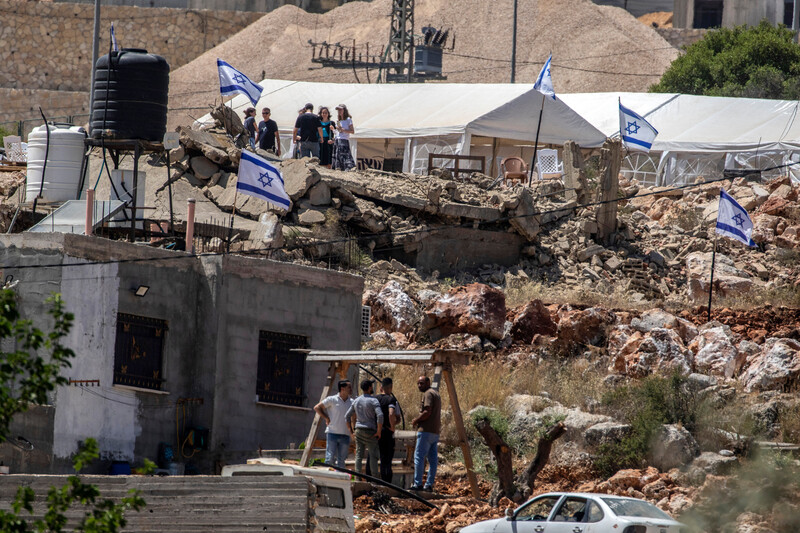
Israeli settlers gather in a new outpost above Palestinian homes in Bruqin village, west of the West Bank city of Salfit, 23 May. The previous night, Israeli settlers seized Palestinian land, attempted to burn Palestinian houses, set fire to agricultural land, raised Israeli flags and began constructing a settlement outpost after a pregnant settler was killed in a shooting attack near the village earlier in the month.
ActiveStillsThe Euro-Med Monitor said on 21 May that it had “documented the deaths of 26 Palestinians, including nine children, in just 24 hours” as a result of “a deliberate Israeli policy that weaponizes hunger and denial of treatment to kill Palestinian civilians.”
“There has been a significant rise in deaths among elderly people, children, and chronically ill patients as a result of hunger and the collapse of healthcare services in the Gaza Strip,” the Geneva-based rights group added.
“The absence of an effective system within Gaza’s Ministry of Health to monitor these deaths means many are officially recorded as stemming from ‘natural causes’,” Euro-Med Monitor said, “despite being directly caused by deliberate starvation policies and the systematic collapse of the health system.”
The UN Committee on the Rights of the Child stated on 21 May that more than 50 children had “died from hunger and many others are on the verge of death” after more than 11 weeks of obstructed humanitarian access.
“If the blockade continues, more children will die and up to 71,000 children under five could suffer from acute malnutrition over the next year,” the committee warned.
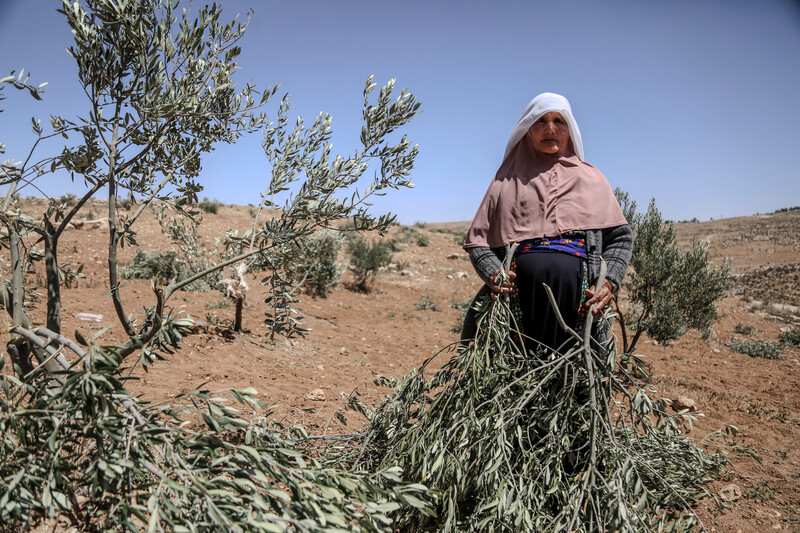
Reda al-Adra collects branches after Israeli settlers cut more than 100 of her olive trees the night before in the Huwwara area east of the West Bank city of Yatta, 24 May.
ActiveStillsThe UN human rights office in the West Bank and Gaza Strip said on 22 May that more than half of the at least 629 Palestinians killed in Gaza over the previous week were in shelters and residential buildings when they were targeted by the Israeli military.
The UN office noted that nine Palestinian journalists were killed, “making this past week one of the deadliest for journalists since 7 October 2023.”
“It appears that in many instances, these journalists may have been deliberately targeted with the intention of limiting the flow of information on what is happening in Gaza and the scale of the impact that this war is having on civilians,” the UN office stated.
Meanwhile, at least 28 aid workers were killed in Gaza during May, “an average of one aid worker killed per day,” OCHA said. “Since 7 October, at least 452 aid workers, including 315 UN staff, have been killed.”
More than one in every 50 UNRWA staff in Gaza has been killed during that period, the UN secretary-general said in early June. “This is the highest staff death toll in United Nations history,” he added.
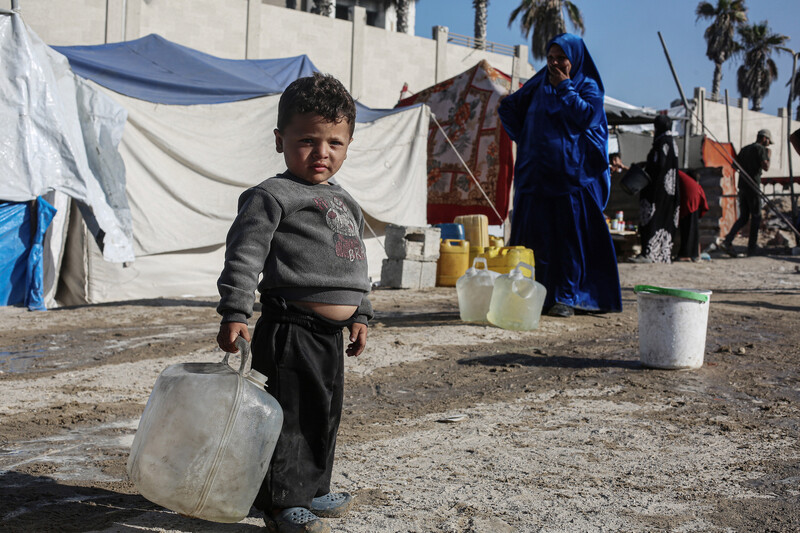
Palestinians try to meet their daily water needs by filling jerry cans with water distributed by tankers as the humanitarian crisis in the region continues to deepen due to the total embargo on Gaza City, 25 May.
APA imagesThe World Health Organization said on 22 May that four major hospitals in Gaza – Kamal Adwan Hospital, Indonesian Hospital, the Hamad Hospital for Rehabilitation and Prosthetics and the European Gazan Hospital – were forced to suspend medical services during the previous week.
The facilities were forced to shutter “due to their proximity to hostilities or evacuation zones,” as well as direct attacks, leaving only 19 of Gaza’s 36 hospitals operational, according to WHO.
“The destruction is systematic,” WHO added. “Hospitals are rehabilitated and resupplied, only to be exposed to hostilities or attacked again. This destructive cycle must end.”
Dr. Majed Jaber, an emergency room physician, was working at the European Gaza Hospital when it was attacked on 13 May. “Sometimes just surviving is a matter of sheer luck,” he told The Electronic Intifada podcast.
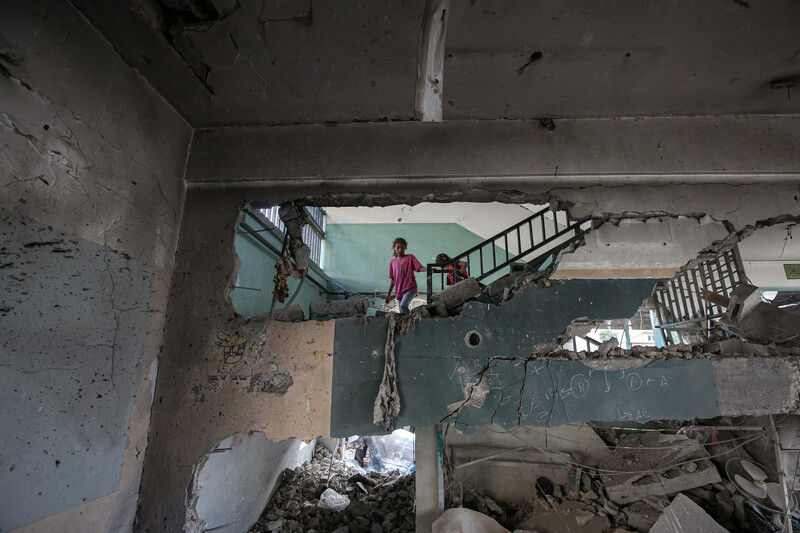
Palestinian children observe the aftermath of an Israeli airstrike on Gaza City’s Fahmi al-Jarjawi school, which was being used as a shelter for displaced people, 26 May. At least 30 people were killed in the attack.
APA imagesAlso on 22 May, the World Food Program said that a handful of bakeries in south and central Gaza supported by the UN agency “have resumed bread production after dozens of trucks were finally able to collect cargo from the Kerem Shalom border crossing and deliver it overnight.”
“These bakeries are now operational distributing bread via hot meal kitchens,” the World Food Program stated. “However, after nearly 80 days of a total blockade of humanitarian assistance, families still face a high risk of famine and far more aid is needed across all of Gaza.”
The UN agency added that more than “140,000 metric tons of food — enough to feed the entire population for two months — is pre-positioned at aid corridors and ready to be brought into Gaza at scale.”
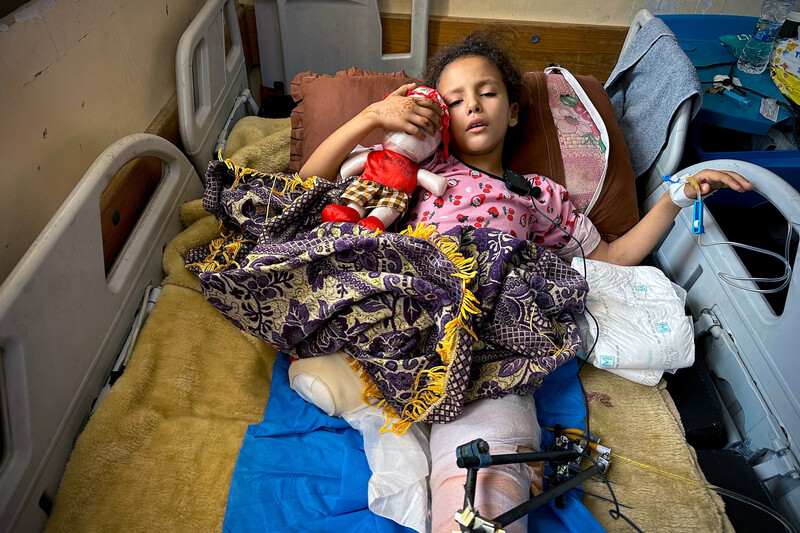
Sila Madi, 8, lies in her hospital bed, as she receives treatment at Nasser Medical Complex in Khan Younis, southern Gaza, 26 May. Sila’s right leg was amputated and her left leg is at risk of amputation due to an Israeli attack that injured several other members of her family.
APA imagesThe UN human rights office said on 23 May that at least 20 families were forced to start leaving Mughayir al-Deir, “the last remaining herding community in eastern periphery of Ramallah,” after Israeli settlers established an outpost next to their homes.
“This follows the forcible transfer of seven other communities in this area as a result of settler violence and harassment coupled with Israeli authorities’ inaction or support,” the UN office said.
“Palestinians have now been completely pushed out of these areas, enabling Israeli settlement expansion and consolidation of annexation of the occupied West Bank.”

Palestinian gymnast Ahmad al-Ghalban, 16, at his family’s in a tent set up amid the ruins of devastated Gaza City, 28 May. Muhammad lost both his legs and several fingers in an Israeli airstrike that targeted in Beit Lahiya, northern Gaza, last March.
APA imagesLess than 5 percent of Gaza’s cropland remains available for cultivation, the Food and Agriculture Organization and the United Nations Satellite Center said in an assessment published on 26 May.
More than 80 percent of Gaza’s cropland has been damaged, with the situation “particularly critical in Rafah and in the northern governorates, where nearly all cropland is not accessible,” the UN agencies said.
Meanwhile, more than 70 percent of Gaza’s greenhouses have been damaged, as well as nearly 83 percent of agricultural wells in the territory.
“This level of destruction is not just a loss of infrastructure – it is a collapse of Gaza’s agrifood system and of lifelines,” Beth Bechdol, a senior FAO official, said. “What once provided food, income and stability for hundreds of thousands is now in ruins.”
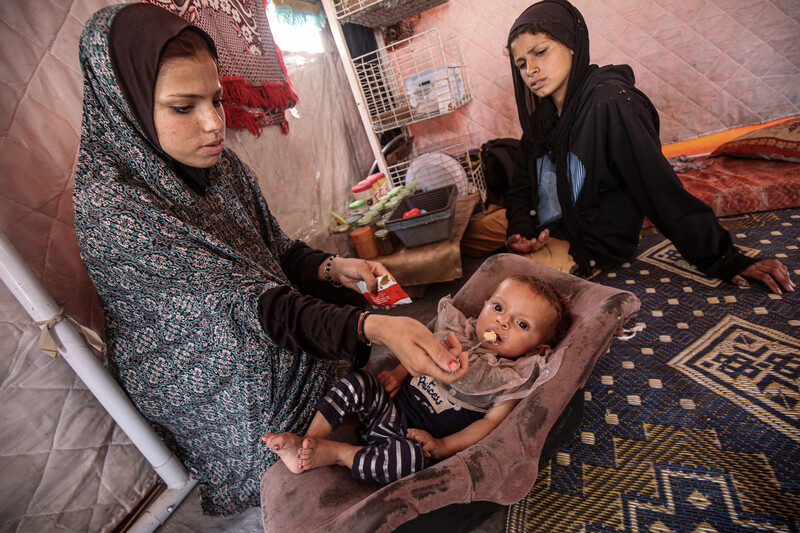
Mervat Hijazi, 38, lives with her nine children in a tent inside a camp for displaced peoplein Gaza City after the Israeli military bombed their home, resulting in the death of her husband. Photographed on 28 May, Mervat and her children are hungry due to the lack of sufficient food and clean water to meet their daily needs.
APA imagesAn inter-agency body coordinating support for internally displaced people stated that nearly 180,000 people were forcibly displaced within Gaza between 15 and 25 May.
“The latest wave of displacement comes as direct attacks on sites have become common, including deadly airstrikes on tents in the al-Mawasi area and a school-turned-shelter in Gaza city,” the Global Camp Coordination and Camp Management Cluster said.
“Intensifying military operations across north Gaza, eastern Khan Younis, and eastern Deir al-Balah over the past 10 days have also caused numerous casualties,” the cluster added.
The cluster said that since 18 March, “nearly 616,000 people have been displaced – multiple times, some as many as 10.”
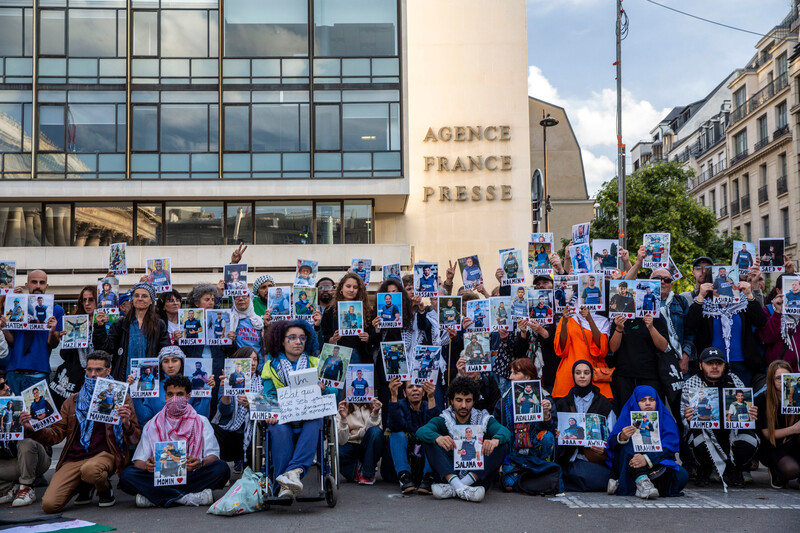
Hundreds gather in front of the offices of Agence France Presse (AFP) in Paris to protest the killing of Palestinian journalists and media workers in Gaza, 28 May.
ActiveStillsBy the end of the month, the number of people displaced since 18 March had risen to 632,000, taking an “immense physical and psychological toll” on those being pushed into “an ever-shrinking space,” the UN Office for the Coordination of Humanitarian Affairs said.
As of 28 May, more than 80 percent of Gaza’s territory was either within an Israeli militarized zone or under forced displacement orders.
Israeli soldiers opened fire near a delegation of diplomats visiting the city of Jenin in the northern West Bank on 21 May, incurring condemnations from even Tel Aviv’s stalwart ally Germany.
“The incident came amid mounting international pressure on Israel to halt its war in Gaza and allow deliveries of aid to reach a population that United Nations experts say is on the brink of famine after an 11-week Israeli blockade,” Reuters reported.

Mourners carry the body of Jassim al-Sadda, 25, who was killed in an Israeli army raid on his home in the village of Jit, east of the West Bank city of Qalqilya, 28 May.
APA imagesOn 23 May, nine children from a single family were killed in an Israeli strike on their home in Khan Younis, southern Gaza. A 10th child was seriously injured, as was Hamdi al-Najjar, the children’s father, who died from his injuries around a week later.
Hamdi had just returned home from dropping his wife, Alaa al-Najjar, off at Nasser Medical Complex, where both parents worked as doctors, before the strike.
“Their children Yahya, Rakan, Ruslan, Jubran, Eve, Rivan, Saydeen, Luqman and Sidra were all killed in the attack,” according to the BBC. “The eldest was 12 years old and the youngest 6 months, according to local media.”
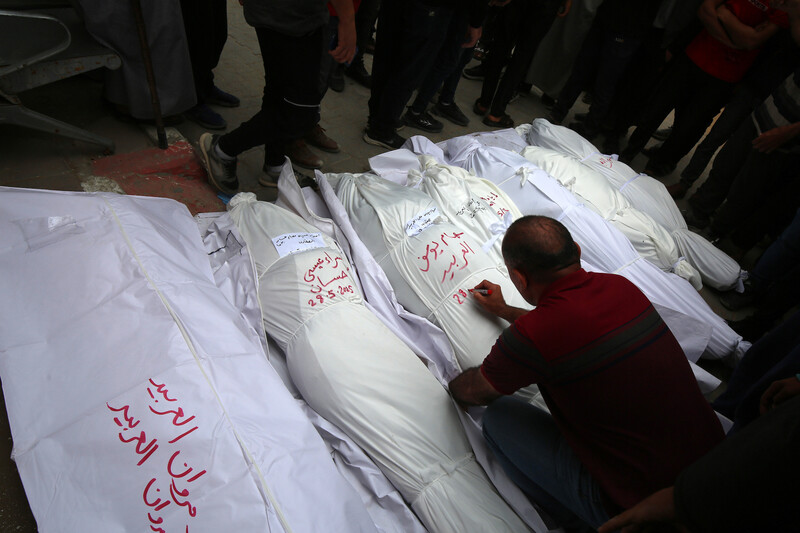
The bodies of Palestinians killed in Israeli strikes on several homes on Saftawi Street, north of Gaza City, are brought to Al-Shifa Hospital, 28 May.
APA imagesOn 25 May, journalist Hassan Majdi Abu Warda and several of his family members were killed in an Israeli airstrike on his home in Jabaliya. The government media office in Gaza said that Abu Warda’s death brought the number of journalists killed in Gaza since October 2023 to 220.
That same day, Ashraf Abu Nar, a senior official in Gaza’s civil defense, was killed along with his wife in an Israeli attack on their home in Nuseirat, central Gaza.
Also on 25 May, the International Committee of the Red Cross stated that two of its staff members, Ibrahim Eid and Ahmad Abu Hilal, were killed in a strike on their homes in Khan Younis the previous day.
On 26 May, the Gaza municipality announced that one of its workers, Muhammad Riyad Musa, was killed and another two were injured while on duty in Gaza City.

A man carries a bag of food aid after people stormed a World Food Program warehouse in Deir al-Balah, central Gaza Strip, on 28 May.
APA imagesOn 26 May, Hamas reportedly executed four men allegedly involved in the looting of aid trucks in Gaza. Citing a source familiar with the incident, Reuters reported that “the four were involved in an incident last week when six security officials were killed by an Israeli airstrike as they were working to prevent gang members from hijacking aid trucks.”
In a press briefing on 28 May marking 600 days of genocide in Gaza, Jonathan Whittall, head of the UN Office for the Coordination of Humanitarian Affairs in the West Bank and Gaza, said that the theft of aid “has been carried out by criminal gangs, under the watch of Israeli forces.”
Whittall noted that the criminal gangs were allowed by the Israeli military to operate near the Kerem Shalom crossing through which aid is being brought into Gaza.
Whittall said that Israel’s claims that international aid is being diverted by Hamas “doesn’t hold up to scrutiny. We do not have evidence that aid coordinated through credible humanitarian charities has been diverted.”

A Palestinian man is rescued after civilians search for people under the rubble of a destroyed building following an Israeli attack on al-Bureij refugee camp, central Gaza Strip, 29 May.
APA imagesThe Palestinian Center for Human Rights said that Israeli forces shot and killed a 30-year-old man named Salem Abu Mousa and wounded dozens of others “after opening fire on thousands of starving Palestinian civilians gathered near an aid distribution point in Rafah,” southern Gaza, on the evening of 27 May.
The aid distribution point is overseen by the Gaza Humanitarian Foundation, the shadowy entity registered in Switzerland that had only just begun handing out food aid packages as part of a militarized scheme boycotted by the UN.
More than 100 Palestinians were killed and nearly 500 others injured while attempting to access aid at the Gaza Humanitarian Fund distribution sites during the scheme’s first eight days of operation, Reuters reported in early June, citing authorities in Gaza.
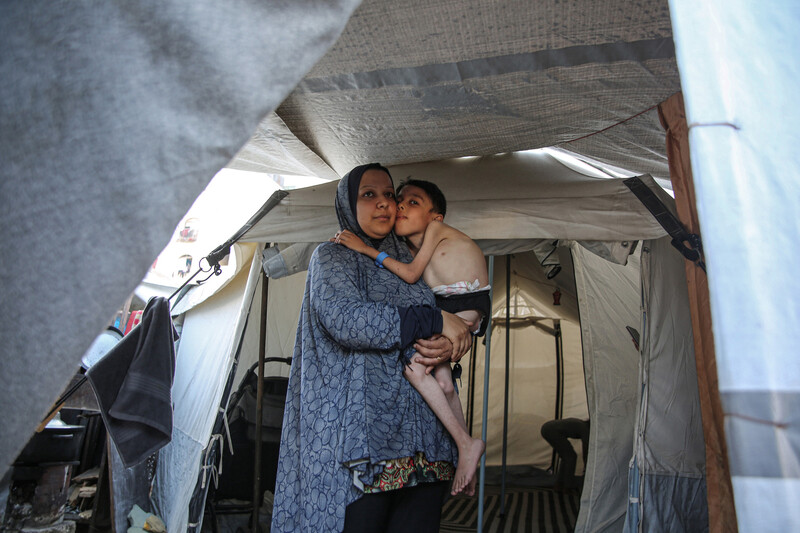
Muhammad Abu Naji, 10, and his mother are photographed in a tent at a shelter center in Gaza City on 29 May. Muhammad has cerebral palsy and his health condition is steadily deteriorating due to the shortage of medications in Gaza’s hospitals and his inability to travel for treatment.
APA imagesOn 28 May, the Humanitarian Country Team – which describes itself as “a strategic decision-making forum” led by the UN humanitarian coordinator for the West Bank and Gaza Strip – said that “the humanitarian situation in Gaza is at its darkest point yet.”
“Over the past days, we’ve submitted 900 truckloads for Israeli approval,” the Humanitarian Country Team stated. “About 800 were cleared and just over 500 could be offloaded on the Israeli side of Kerem Shalom. We have been able to collect only about 200 on the Palestinian side of the crossing due to insecurity and restricted access.”
“While letting us bring in some nutrition and medical supplies, as well as flour, Israeli authorities have banned most other items, including fuel, cooking gas, shelter and hygiene products,” the country team added.
Regarding the “new militarized distribution system” that was launched, the country team said that “it does not align with humanitarian principles, it puts people at risk, and it will not meet people’s needs, or dignity, across Gaza.”
On 28 May, the World Food Program said that “hordes of hungry people” broke into its warehouse in Deir al-Balah, central Gaza, “in search of food supplies that were pre-positioned for distribution.”
Two people reportedly died in the incident.
Three days earlier, Cindy McCain, the director of the World Food Program, told the US television program Face the Nation that there was no evidence of Hamas stealing food aid since Israel allowed for an extremely limited resumption of aid into the territory.
The UN agency’s trucks were being looted by “people who are starving to death,” she said.

Palestinians evacuate people who were shot by the Israeli army near an aid distribution center in the central Gaza Strip, 30 May.
APA imagesOn 30 May, Francesca Albanese, an independent UN human rights expert, called on the international community to stop Israel’s use of “humanitarian language and mechanisms” to obscure and facilitate “the commission of atrocity crimes in Gaza.”
She noted that three people were reported killed, dozens were injured and several went missing when thousands of Palestinians approached the Gaza Humanitarian Foundation to receive aid on 27 May.
“To starve a population for months and then shoot at them when they clamor for food is unmitigated cruelty,” Albanese said.
“The time for sanctions is now,” she added, “as Israeli politicians continue to call for the extermination of babies while over 80 percent of the Israeli society, according to Israeli media, ask for the forcible removal of Palestinians from Gaza.”

Amro al-Hams, 3, receives medical care at Nasser Medical Complex in Khan Younis after being injured by a shrapnel wound to the brain. He was transferred from the Indonesian Hospital in northern Gaza, where he had been receiving treatment accompanied by his grandmother, following the killing of his parents. The transfer was made necessary due to the Israeli army’s siege of the hospital. His health condition continues to deteriorate due to the severe shortage of medications in Gaza’s hospitals and his inability to travel for treatment as a result of the closure of border crossings, 31 May.
APA imagesIn late May, the Haaretz newspaper reported that an Israeli was being held on suspicion of “murder on nationalist grounds of a Palestinian resident of East Jerusalem.”
Fuad Alian was reportedly chased by assailants while in a park in the western sector of Jerusalem on 22 May. One of the assailants allegedly ran over Alian while he and his cousin were trying to escape on a motorcycle.
Three Palestinians were killed by Israeli forces in the West Bank over 24 hours between 27 and 28 May. Two were slain in separate raids in Jit village and in Jericho, and the third was killed in Nablus.
The man killed in Nablus was “shot outside of his shop and was not involved in the confrontations” that broke out during an Israeli military raid on 27 May, OCHA reported, citing local sources
The man killed in Jit, near Qalqiliya, was shot while he was sleeping by Israeli forces during a raid on his home. The soldiers prevented the shot man’s family from transporting him to a hospital, “leaving the young man to bleed to death,” OCHA reported.
Meanwhile, settlers torched cars and graffitied racist slogans in homes in Rammun, a village near the West Bank city of Ramallah, and settlers threw stones at homes and set fire to vehicles in Qaryut village near Nablus.
Settlers had set fire to crops in al-Mughayir village near Ramallah and set up tents in several locations in the Ramallah area, as well as in Jericho and near Nablus, according to a Palestinian Authority official.
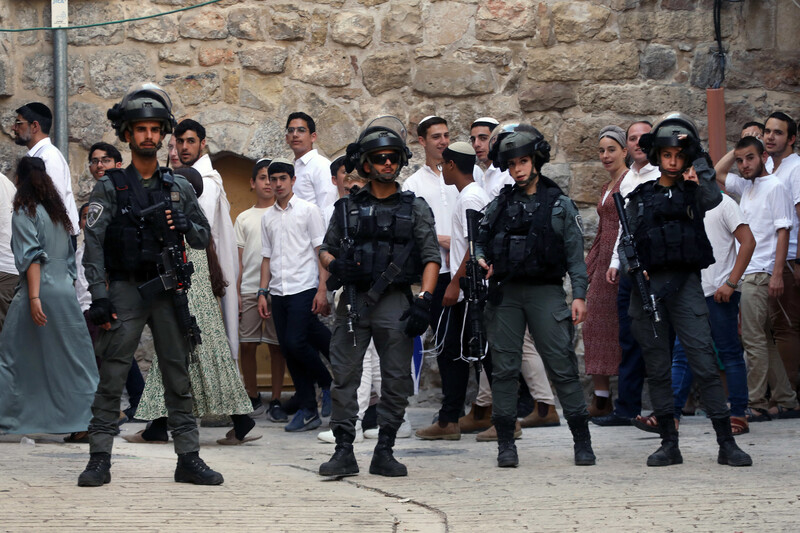
Israelis take a provocative tour of the West Bank City of Hebron under the protection of Israeli forces, 31 May.
APA imagesOn 31 May, Hamas said that it was seeking changes to a proposal for a 60-day truce in Gaza backed by the US that would reportedly see the release of 28 Israeli captives, both alive and dead, in exchange for 1,236 Palestinian prisoners and the remains of 180 Palestinians whose bodies are being held by Israel.
As of late May, more than 10,000 Palestinians from the West Bank and Gaza were in Israeli custody, exclusive of Palestinians from Gaza being detained by the Israeli military. Of the 10,000 prisoners and detainees, nearly 3,600 were being held without charge or trial under administrative detention orders and nearly 1,850 were being held as “unlawful combatants.”
The Palestinian Prisoners Society announced on 22 May that it had confirmed the death of Amr Hatem Odeh, a 33-year-old in Gaza, while he was being held at Sde Teiman, the notorious Israeli torture and detention camp, on 13 December 2023. At least 70 Palestinians have died in Israeli custody since October 2023, including 44 detainees from Gaza.
The US-backed temporary truce proposal also includes a resumption of humanitarian aid to Gaza, to be delivered by the UN, the Red Crescent and other agencies, according to Reuters.
“[Hamas] said it was willing to release 10 living hostages and hand over the bodies of 18 dead in exchange for Palestinian prisoners in Israeli prisons,” Reuters reported. “But Hamas reiterated demands for an end to the war and withdrawal of Israeli troops from Gaza, conditions Israel has rejected.”
Meanwhile, the Israeli military claimed on 31 May that it had killed Hamas leader Muhammad Sinwar in a strike in Gaza earlier in the month. Muhammad was the younger brother of Yahya Sinwar, the Hamas leader who was killed in battle in southern Gaza in October last year.
A third brother, Zakaria Sinwar, was critically injured in a targeted Israeli strike that killed three of his sons in Nuseirat refugee camp in central Gaza in mid-May. Zakaria, a prominent academic in Gaza, died of his injuries around a week after the attack.
Text and production by Maureen Clare Murphy.
